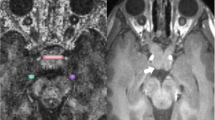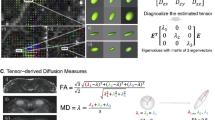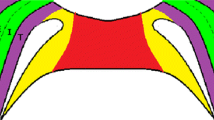Abstract
Background
Optic pathway glioma (OPG) is a characteristic hallmark of neurofibromatosis type I (NF-I).
Objective
To evaluate the feasibility of magnetic resonance diffusion tensor imaging (MRDTI) at 3T to detect abnormalities of the optic nerves and optic radiations in children with NF-I.
Materials and methods
3-T MRDTI was prospectively performed in 9 children with NF-I (7 boys, 2 girls, average age 7.8 years, range 3–17 years) and 44 controls (25 boys, 19 girls, average age 8.1 years, range 3–17 years). Fractional anisotropy (FA) and mean diffusivity were determined by region-of-interest analysis for the optic nerves and radiations. Statistical analysis compared controls to NF-I patients.
Results
Two NF-I patients had bilateral optic nerve gliomas, three had chiasmatic gliomas and four had unidentified neurofibromatosis objects (UNOs) along the optic nerve pathways. All NF-I patients had statistically significant decreases in FA and elevations in mean diffusivity in the optic nerves and radiations compared to age-matched controls.
Conclusion
MRDTI can evaluate the optic pathways in children with NF-I. Statistically significant abnormalities were detected in the diffusion tensor metrics of the optic nerves and radiations in children with NF-I compared to age-matched controls.




Similar content being viewed by others
References
Stern J, Jakobiec FA, Housepian EM (1980) The architecture of optic nerve gliomas with and without neurofibromatosis. Arch Ophthalmol 98:505–511
Lewis RA, Gerson LP, Axelson KA et al (1984) Neurofibromatosis. II. Incidence of optic nerve gliomata. Ophthalmology 91:929–935
Gayre GS, Scott IU, Feuer W et al (2001) Long-term visual outcome in patients with anterior visual pathway gliomas. J Neuroophthalmol 21:1–7
Rush JA, Younge BR, Campbell RJ et al (1982) Optic glioma: long-term follow-up of 85 histopathologically verified cases. Ophthalmology 89(11):1213–1219
Lund AM, Skovby F (1991) Optic gliomas in children with neurofibromatosis type I. Eur J Pediatr 150:835–838
Thiagalingam S, Flaherty M, Billson F et al (2004) Neurofibromatosis type I and optic pathway gliomas: follow-up of 54 patients. Ophthalmology 111:568–577
Listernick R, Charrow J, Greenwald M et al (1994) Natural history of optic pathway tumors in children with neurofibromatosis type I: a longitudinal study. J Pediatr 125:63–66
Hoyt WF, Baghdassarian SA (1969) Optic glioma of childhood: natural history and rationale for conservative management. Br J Ophthalmol 53:793–798
Listernick R, Darling C, Greenwald M et al (1995) Optic pathway tumors in children: the effect of neurofibromatosis type I on clinical manifestations and natural history. J Pediatr 127:718–722
Wright JE, McDonald WI, Call NB (1980) Management of optic nerve gliomas. Br J Ophthalmol 64:545–552
Listernick R, Louis DN, Packer RJ et al (1997) Optic pathway gliomas in children with neurofibromatosis I: consensus statement from the NF-I Optic Nerve Pathway Glioma Task Force. Ann Neural 41:143–149
Listernick R, Charrow J, Guttmann DH (1999) Intracranial gliomas in neurofibromatosis type I. Am J Med Genet 89(1):38–44
Grill J, Lather V, Rodriguez D et al (2000) When do children with optic pathway tumors need treatment? An ontological perspective in 106 patients treated in a single centre. Eur J Pediatr 159:692–696
Deliganis AV, Geyer JR, Berger MS (1996) Prognostic significance of type I neurofibromatosis (von Recklinghausen disease) in childhood optic glioma. Neurosurgery 38:1114–1118
Gottschalk S, Tavakolian R, Buske A et al (1999) Spontaneous remission of chiasmatic/hypothalamic masses in neurofibromatosis type I: a report of two cases. Neuroradiology 41:199–201
Schmandt SM, Packer RJ, Vezina LG (2000) Spontaneous regression of low-grade astrocytomas in childhood. Pediatr Neurosurg 32:132–136
Perilongo G, Moras P, Carollo C et al (1999) Spontaneous partial regression of a low-grade glioma in children with neurofibromatosis-I: a real possibility. J Child Neurol 14:352–356
Blazo MA, Lewis RA, Chintagumpala MM (2004) Outcomes of systematic screening for optic pathway tumors in children with neurofibromatosis type I. Am J Med Genet A 127A(3):224–229
Stern J, DiGiacinto GV, Housepian EM (1979) Neurofibromatosis and optic glioma: clinical and morphological correlations. Neurosurgery 4:524–528
Borit A, Richardson EP Jr (1982) The biological and clinical behavior of pilocytic astrocytomas of the optic pathways. Brain 105:161–187
Balcer LJ, Liu GT, Heller G et al (2001) Visual loss in children with neurofibromatosis type I and optic pathway gliomas: relation to tumor location by magnetic resonance imaging. Am J Ophthalmol 131(4):442–445
van Engelen SJPM, Krab LC, Moll HA et al (2008) Quantitative differentiation between healthy and disordered brain matter in patients with neurofibromatosis type I using diffusion tensor imaging. AJNR 29:816–822
Salmela MB, Cauley KA, Nickerson JP et al (2010) Magnetic resonance diffusion tensor imaging (MRDTI) and tractography in children with septo-optic dysplasia. Pediatr Radiol 40(5):708–713
Yamamoto A, Miki Y, Urayama S (2007) Diffusion tensor fiber tractography of the optic radiation: analysis with 6-, 12-, 40-, and 81-directional motion-probing gradients. A preliminary study. AJNR 28:92–96
Basser PJ, Jones DK (2002) Diffusion-tensor MRI: theory, experimental design, and data analysis-a technical review. NMR Biomed 15:457–467
Mori H, Abe O, Okubo T et al (2001) Diffusion property in a hamartomatous lesion of neurofibromatosis type I. J Comput Assist Tomogr 25:537–539
Eastwood JD, Fiorella DJ, MacFall JF et al (2001) Increased brain apparent diffusion coefficient in children with neurofibromatosis type I. Radiology 219:354–358
Alkan A, Sigirci A, Kutlu R et al (2005) Neurofibromatosis type I: diffusion weighted imaging findings of brain. Eur J Radiol 56:229–234
Tognini G, Ferrozzi F, Garlaschi G et al (2005) Brain apparent diffusion coefficient evaluation in pediatric patients with neurofibromatosis type I. J Comput Assist Tomogr 29:298–304
Zamboni SL, Loenneker T, Boltshauser E et al (2007) Contribution of diffusion tensor MR imaging in detecting cerebral microstructural changes in adults with neurofibromatosis type I. AJNR 28:773–776
Nickerson JP, Salmela MB, Koski CJ et al (2010) Diffusion tensor imaging of the pediatric optic nerve: intrinsic and extrinsic pathology compared to normal controls. J Magn Reson Imaging 32:76–81
Sener RN (2002) Diffusion MR in neurofibromatosis type I: ADC evaluations of the optic pathways and a comparison with normal individuals. Comput Med Imaging Graph 26(2):59–64
Ono J, Harada K, Mano T et al (1997) Differentiation of dys- and demyelination using diffusional anisotropy. Pediatr Radiol 16:63–66
DiPaolo DP, Zimmerman RA, Rorke LB et al (1995) Neurofibromatosis type I: pathologic substrate of high signal intensity foci in the brain. Radiology 195:721–724
Trip SA, Wheeler-Kingshott C, Jones SJ et al (2006) Optic nerve diffusion tensor imaging in optic neuritis. Neuorimage 30:498–505
Xu J, Sun SW, Naismith RT et al (2008) Assessing optic nerve pathology with diffusion MRI: from mouse to human. NMR Biomed 21:928–940
Author information
Authors and Affiliations
Corresponding author
Rights and permissions
About this article
Cite this article
Filippi, C.G., Bos, A., Nickerson, J.P. et al. Magnetic resonance diffusion tensor imaging (MRDTI) of the optic nerve and optic radiations at 3T in children with neurofibromatosis type I (NF-1). Pediatr Radiol 42, 168–174 (2012). https://doi.org/10.1007/s00247-011-2216-y
Received:
Revised:
Accepted:
Published:
Issue Date:
DOI: https://doi.org/10.1007/s00247-011-2216-y




